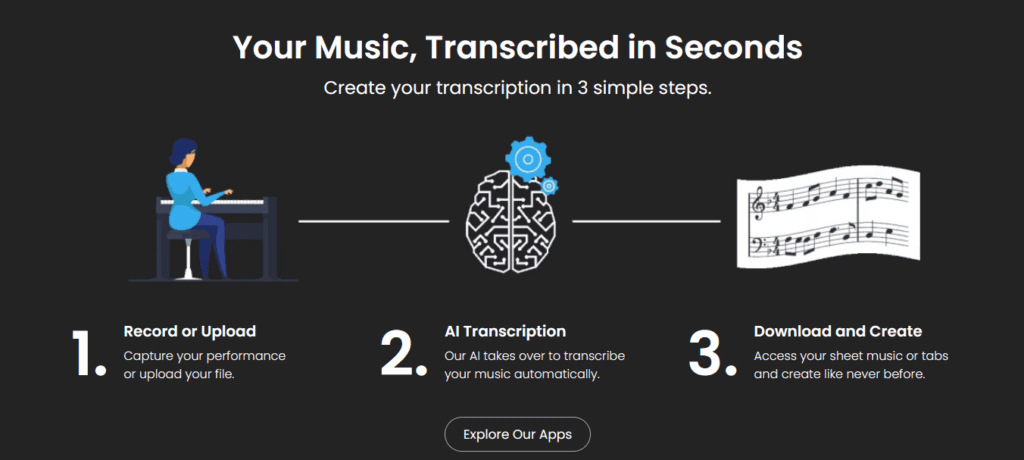Learning how to transcribe different instruments by ear is an invaluable skill for musicians seeking to improve their musicality. This comprehensive guide will teach you proven methods for transcribing music to boost your listening abilities, technique, and understanding of music theory.
What is a Music Transcription, and Why are they Important?
A music transcription is the process of notating melodies, chords, rhythms, and other musical elements simply by listening to a recording. Mastering transcription skills allows you to recreate music without sheet music and learn pieces entirely by ear.
Transcribing develops your ear training, enhances your knowledge of music theory, and elevates your musicianship. It improves your ability to recognize intervals, chords, rhythmic patterns, and melodic phrasing. Transcription is an essential skill for all musicians that boosts your technique, memorization abilities, and improvisation skills.
Boost your Progress with some of Klangio’s AI Magic

While gaining the skills to recognizing and notating musical elements by ear is extremely important in various scenarios, it’s also important not to ignore recent advancements for tools that make this process easier. The Klangio applications allow you to transcribe music of various instruments within just a couple seconds! You can try out Piano2Notes, Guitar2Tabs, Sing2Notes and Melody Scanner for free as much as you like. Use these tools to compare your transcription by ear to what the AI recognizes, to make even faster progress.
Step-by-Step Guide to Transcribing Music
Follow this step-by-step process to start transcribing music on your instrument:
1. Pick an Appropriate Recording
Choose a high-quality recording of a song you enjoy and are very familiar with. Short melodies and simple chord progressions are best for beginners. Go for Pop Songs that everybody knows, or that one song that’s stuck on your mind anyway, instead of complex jazz arrangements.
2. Determine the Key and Time Signature
Figure out the key and time signature by listening to the introduction and main rhythmic feel. This provides the framework for your transcription. Counting and clapping along the beat helps to figure out the measurement in an instant. Finding the one of the measurements can give a valuable hint of what the root of the song is. Feel free to use an instrument to confirm which notes harmonies the best with the overall chord progression.
3. Isolate the Main Melody
Focus only on the main melody first. Pick out each note carefully and notate the rhythm precisely. Loop smaller challenging sections. Humming along helps to let the melody sink in before trying to note it down.
4. Add the Harmony
Determine the underlying chords and harmonic rhythm. For polyphonic instruments, listen for multiple voices and lines. When you’re starting to get into transcribing by ear, keep the transcribed chords simple. It’s even better to start off by trying to recognize just the root of the chord, and then slowly work yourself up to determine if it’s a Major or a Minor. Don’t get lost in the details!
5. Notate Additional Elements
Include important details like grace notes, articulations, ornaments, slides, vibratos, and idiomatic phrasing. Especially, Guitars can bring a wide variety of frequently used note effects and playing techniques with them. Wrapping your head around them can be a bit tough at first.
Note that these articulations always make sense in the context of the whole song. The overall feel of a section are great indications if your recognized articulations are correct.
6. Check Accuracy and Fix Errors
Verify your transcription against the original recording. Fix any wrong notes, rhythms, chords, or other errors. Again, don’t hesitate to use the Klangio Applications to check on your progress for free.
7. Practice Small Sections
Slowly practice short excerpts to reinforce correct notes, fingerings, voicings, and technique. Gradually piece together the full transcription.
With regular practice, you can become proficient at accurately transcribing music on your instrument. Be patient and celebrate small victories in your development.
Helpful Tips for Transcribing Music on Various Instruments
While the process is similar, there are instrument-specific tips that can help you succeed when transcribing:
- Piano: Focus on capturing the melody, harmony, and chord voicings accurately. Listen for countermelodies, bass lines, and embellishments.
- Guitar: Use tablature and chord charts to notate guitar parts. Determine chord shapes, inversions, and picking patterns. Isolate multiple lines.
- Voice: Precisely notate vocal melodies, lyrics, rhythms, runs, riffs, and ornamentations. Recreate stylistic phrasing and embellishments.
- Other Instruments: Emphasize characteristic tone, articulation, idiomatic techniques, and melodic variations. Strive to recreate an authentic sound.
Slow down the recording and loop challenging sections. Transcribe in small pieces and double check your work against the original.
Benefits of Transcription for Musical Growth
Regularly transcribing music provides many invaluable benefits for musicians:
- Improves ear training skills and listening accuracy
- Develops stronger technical mastery and finger dexterity
- Deepens understanding of music theory, phrasing, and articulation
- Boosts memorization skills by learning pieces by ear
- Aids self-teaching by reducing reliance on sheet music
- Provides personalized practice material from your own transcriptions
- Enhances improvisation abilities from enhanced musical pattern recognition
- Allows learning of music without available sheet music
Make transcription a consistent part of your practice routine to see these areas of musicality thrive.
Take Your Musicianship to the Next Level with Transcription
Learning to accurately transcribe music is one of the best investments of practice time any musician can make. Start by picking simple, familiar songs and focus on small sections at a time. Loop recordings and don’t get discouraged. With regular practice, you’ll be surprised how rapidly your transcription skills improve.
Unlocking the ability to learn music by ear will profoundly deepen your musical understanding and skills. If you’re committed to growth as a musician, invest the time into mastering transcription. You’ll open up an entirely new world of musical possibility and autonomy.

